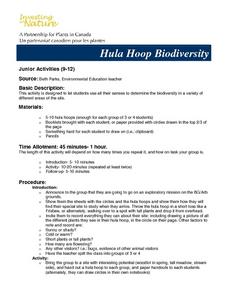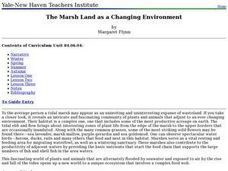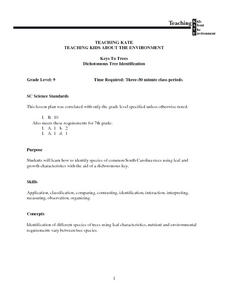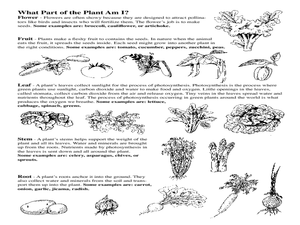Curated OER
THE PEANUT WIZARD
Students read information about George Washington Carver and outline the information. They are given peanuts in the shell, students examine them and eat them. Students discuss the following questions: Why did George Washington Carver...
Curated OER
Hula Hoop Biodiversity
Students determine the biodiversity in a variety of different areas. They record everything they can about their site- including drawing a picture of all the different plants they see in their hula hoop, in the circle on their page.
Curated OER
Ecology - Reproduction and heredity
Students correlate signs of spring with reproductive strategies of varioius organisms. They describe how organisms inherit traits from generation to generation.
Curated OER
The Empty Pot: A Lesson About Integrity
Learners discuss whether honesty really is the best policy with a lesson plan on "The Empty Pot," a Chinese fable about integrity. After reading the story, class members answer several comprehension and reflection questions about...
Curated OER
Web of Life - Role-Playing
Young scholars role-play how organisms adapt to their environment. They play 20 questions with plant and animal habitats. They create a web of life to demonstrate how each plant and animal relies on the other for survival.
Curated OER
The Marsh Land as a Changing Environment
Sixth graders continue their examination of the state of Connecticut. After taking a field trip, they identify the types of birds, plants, invertebrates and vertebrates who make their home in the salt marshes. In groups, they identify...
Curated OER
A Wild Chain Reaction
Students explore habitats. In this habitat instructional activity, students break into groups and are labeled as a part of a habitat. Students then do an activity with yarn that shows how all of the parts are connected...
Curated OER
Painting Botanicals by Computer
Students increase their computer graphics skills and trace and paint botanicals from digitals photographs they take of prairie plants using computer-aided artistic techniques.
Curated OER
Natural Inspiration
Students relate math to the real world. In this algebra lesson plan, students compare plants to math and relate their artistic ability to concepts in math. They draw pictures of flowers, leaves and trees.
Curated OER
Keys To Trees: Dichotomous Tree Identification
Ninth graders gather samples of different tree leaves in their neighborhoods, and on school grounds, and identify several species of common South Carolina trees using leaf and growth characteristics with aid of dichotomous key.
Curated OER
Too Bee Or Not To Bee
Students recognize that bees are important in the reproduction of plants and to the survival of animals. In this bee lesson, students become familiar with the parts of bees and how those adaptations help them pollinate plants....
Curated OER
Celebrate Sunflowers
Students skip count with sunflower seeds. In this interdisciplinary lesson, students discuss the history of sunflowers. Students count by 1's, 2's, and 10's with bags full of sunflower seeds.
Curated OER
Corn and Tortillas
In this reading comprehension worksheet, learners read a 1-page selection regarding corn and then respond to 7 matching questions regarding foods made with corn. Students then respond to 7 matching questions involving Spanish words. A...
Curated OER
Vocabulary Practice: Cross Out the Incorrect Word
In this editing worksheet, learners read ten sentences and look for the error. Students cross out the incorrect word and replace it with the logical word from the word list.
Curated OER
Fruit or Vegetable?
Watermelon is a vegetable? A tomato is a fruit? Believe it or not, this debate is decades old. Groups examine rulings by the US Supreme Court, the USDA, and state statutes before developing their own criteria to use when labeling...
Curated OER
Now You See It, Now You Don't
Students explore organic and inorganic objects. In this environmental lesson plan students perform a composting experiment using flowers in different soils. Students record their observations.
Curated OER
When Dinosaurs Ruled
Students research about plants and animals during Triassic period. In this earth science lesson, students draw pictures of their chosen plants and plants for the bulletin board. They present their project in class.
Curated OER
Is Purple Loosestrife a Problem Near Our School?
Students explore to investigate if the distribution of Purple loosestrife around the school district area is relevant to its distribution and control. They create a comprehensive map to support their thesis and data and then head out...
Curated OER
Let's Sort a Salad
Learners examine edible plants by identifying salad ingredients. In this botany lesson, students discuss the different vegetables that can be eaten in a salad and draw them on a worksheet. Learners review vegetable vocabulary and examine...
Curated OER
Toilet Paper Geologic Time Scale
Students examine and demonstrate the extent of geologic time compared to recent time. They develop a demonstration of geologic time using an unrolled roll of toilet paper, with each sheet of toilet paper representing 20 million years.
Curated OER
Plant Parts Resource Pages
In this plant worksheet, students study the names of plant parts and the function of each part. There are no questions associated with this page.
Curated OER
Meadows Observations
Students investigate and examine the different living things they find in a meadow. Students record the different colors that are present and create a graph, identify and label parts of a plant, use a magnifying lens to examine all ...
Curated OER
Plant Party
Young scholars identify plant parts. In this plants lesson, students bring in a vegetable. Each student classifies which part of the plant their vegetable comes from (flower, root, ect.) Young scholars identify the parts of their...
Curated OER
Parts of a Plant
Students record observations about parts of plants including leaves, roots, stems, and flowers. They use Kid Pix to draw a picture of a plant and to label the parts of the plant.























